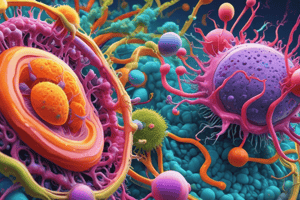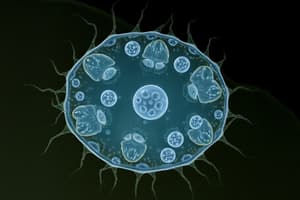Podcast
Questions and Answers
Who is credited with discovering the nucleus of a cell?
Who is credited with discovering the nucleus of a cell?
- Matthias Schleiden
- Theodore Schwann
- Robert Brown (correct)
- Anton Von Leeuwenhoek
What is the fundamental structural and functional unit of all living organisms?
What is the fundamental structural and functional unit of all living organisms?
- Plasma membrane
- Cell (correct)
- Tissue
- Organ
Which scientist first saw and described a live cell?
Which scientist first saw and described a live cell?
- Robert Brown
- Matthias Schleiden
- Anton Von Leeuwenhoek (correct)
- Theodore Schwann
Who reported that cells had a thin outer layer known today as the 'plasma membrane'?
Who reported that cells had a thin outer layer known today as the 'plasma membrane'?
What characteristic ensures independent living for unicellular organisms?
What characteristic ensures independent living for unicellular organisms?
What did Rudolf Virchow contribute to the cell theory?
What did Rudolf Virchow contribute to the cell theory?
What is the main arena of cellular activities in both plant and animal cells?
What is the main arena of cellular activities in both plant and animal cells?
Which type of cells contain membrane-bound organelles like endoplasmic reticulum and golgi complex?
Which type of cells contain membrane-bound organelles like endoplasmic reticulum and golgi complex?
What is the function of ribosomes within a cell?
What is the function of ribosomes within a cell?
Which organelle found in animal cells helps in cell division?
Which organelle found in animal cells helps in cell division?
Flashcards are hidden until you start studying
Study Notes
Characteristics of Living Organisms
- The presence of cells is the basic unit of life that distinguishes living organisms from non-living things.
- All organisms, whether unicellular or multicellular, are composed of cells.
Unicellular Organisms
- Unicellular organisms are capable of independent existence and performing essential functions of life.
- Anything less than a complete cell structure does not ensure independent living.
Cell Theory
- In 1838, Matthias Schleiden observed that all plants are composed of different kinds of cells that form tissues.
- Theodore Schwann, in 1839, studied animal cells and reported that cells have a thin outer layer called the plasma membrane.
- Schwann proposed that bodies of animals and plants are composed of cells and products of cells.
- Rudolf Virchow, in 1855, explained that cells divide and new cells are formed from pre-existing cells (Omnis cellula-e cellula).
- The cell theory states that all living organisms are composed of cells and products of cells, and all cells arise from pre-existing cells.
Cell Structure
- Plant cells have a distinct cell wall as their outer boundary and a cell membrane just within it.
- Animal cells have an outer membrane as the delimiting structure of the cell.
- Cells have a dense membrane-bound structure called the nucleus, which contains chromosomes and genetic material (DNA).
- Cells have a semi-fluid matrix called cytoplasm, which is the main arena of cellular activities.
- Eukaryotic cells have membrane-bound organelles like the endoplasmic reticulum (ER), golgi complex, lysosomes, mitochondria, microbodies, and vacuoles.
- Prokaryotic cells lack membrane-bound organelles.
- Ribosomes are non-membrane bound organelles found in all cells.
- Cells differ greatly in size, shape, and activities.
Studying That Suits You
Use AI to generate personalized quizzes and flashcards to suit your learning preferences.




